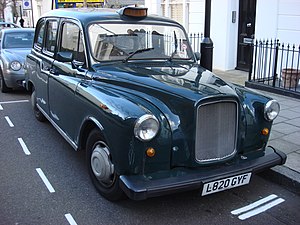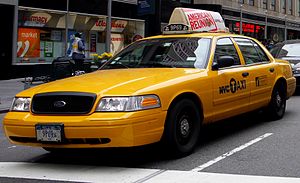Taxi

Ataxi(taxicaborcabin theUnited States) is acar,or othervehiclewhich is used forpublic transport.People use them to get to where they want to go. This means there are no stops in between where they get on and where they get off. Many bigcitieshave taxis.
In most other types of public transport, such as abus,tram,ortrain,the rider does not get to choose the locations where they want to get picked up or dropped off. These vehicles often take certainroadsor follow a very specificroute.Because of this, they usually do not stop exactly where people want to go.
Riding a taxi is a lot like a person having their own car, but don'tdriveit. They only tell the taxidriverwhere they want to go and he or she will take you there. How much they pay for the ride, in most cases, depends on how far they are going from where you get on. It is common for thepricefor a taxi ride to be more expensive than other forms of transport.
History
[change|change source]
The first taxi-type system started inParisandLondonin the early17th century.These were carts pulled by (carriages) and could be hired. Themonarchiesthat ruled these cities controlled the rules. In the19th century,Hansom cabswere mostly used because of their higher level of safety.
Taximeter
[change|change source]The 1891 invention byGermanWilhelm Bruhnof thetaximeterhelped establish the modern taxi. The first modern meter-equipped taxicab was theDaimler Victoria,built byGottlieb Daimlerin 1897. The first motorized taxi company began operating inStuttgartthe same year.
The termtaximeteris an adaptation of theFrenchword 'taximètre', and theGermanword 'taxameter'. It means measuring ataxorfee.[1][2][3]
Related pages
[change|change source]References
[change|change source]- ↑"History of the Licensed London Taxi".london-taxi-cabs.com. Archived fromthe originalon 29 April 2015.Retrieved22 April2015.
- ↑Firth, C.H.; Rait, R.S., eds. (1911),"June 1654: An Ordinance for the Regulation of Hackney-Coachmen in London and the places adjacent",Acts and Ordinances of the Interregnum, 1642–1660,London: British History Online, pp. 922–924, archived fromthe originalon 5 August 2011,retrieved22 April2015
- ↑"Les taxis: 378 ans d'histoires et d'engueulades".14 June 2015.
